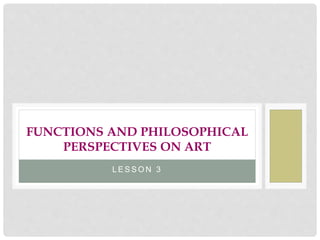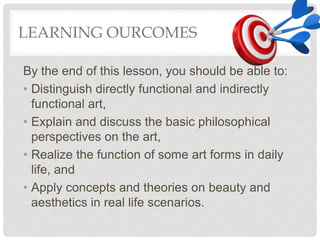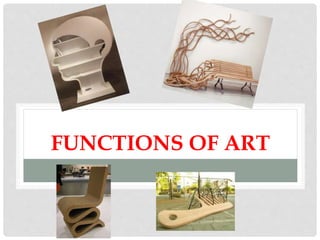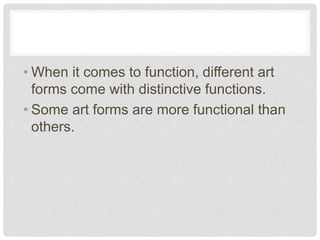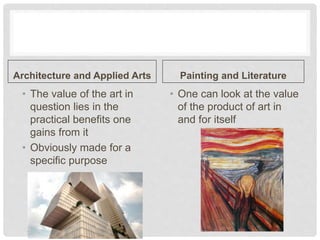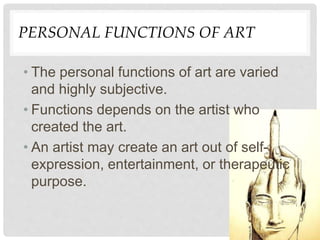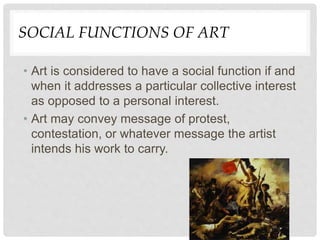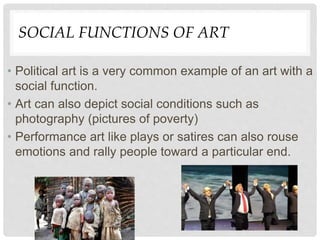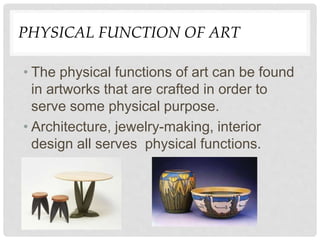Functions and Philosophical Perspectives on Art
- 1. L E S S O N 3 FUNCTIONS AND PHILOSOPHICAL PERSPECTIVES ON ART
- 2. LEARNING OURCOMES By the end of this lesson, you should be able to: • Distinguish directly functional and indirectly functional art, • Explain and discuss the basic philosophical perspectives on the art, • Realize the function of some art forms in daily life, and • Apply concepts and theories on beauty and aesthetics in real life scenarios.
- 3. • Aristotle claimed that every particular substance in the world has an end, or telos in Greek, which translates into “purpose.” • Every substance, defined as formed matter, moves according to a fixed path towards its aim.
- 4. •This telos, according to Aristotle, is intricately linked with function. •For a thing to reach its purpose, it also has to fulfill its function.
- 6. • An inquiry on the function of art is an inquiry on what art is for. • Example: What is the Rizal monument for?
- 7. • When it comes to function, different art forms come with distinctive functions. • Some art forms are more functional than others.
- 8. Architecture and Applied Arts • The value of the art in question lies in the practical benefits one gains from it • Obviously made for a specific purpose Painting and Literature • One can look at the value of the product of art in and for itself
- 9. DOES IT MEAN THAT PAINTINGS AND LITERARY WORKS CAN NEVER HAVE ANY FUNCTION? • Dr. Jose Rizal’s Noli Me Tangere and El Filibustirismo • The novels accrued value and as a consequence, function. • They are functional in so far as they are designed to accomplish some definite end.
- 10. PERSONAL FUNCTIONS OF ART • The personal functions of art are varied and highly subjective. • Functions depends on the artist who created the art. • An artist may create an art out of self- expression, entertainment, or therapeutic purpose.
- 11. SOCIAL FUNCTIONS OF ART • Art is considered to have a social function if and when it addresses a particular collective interest as opposed to a personal interest. • Art may convey message of protest, contestation, or whatever message the artist intends his work to carry.
- 12. SOCIAL FUNCTIONS OF ART • Political art is a very common example of an art with a social function. • Art can also depict social conditions such as photography (pictures of poverty) • Performance art like plays or satires can also rouse emotions and rally people toward a particular end.
- 13. PHYSICAL FUNCTION OF ART • The physical functions of art can be found in artworks that are crafted in order to serve some physical purpose. • Architecture, jewelry-making, interior design all serves physical functions.
- 14. OTHER FUNCTIONS OF ART • Music was principally used for dance and religion. • The ancient world saw music as an instrument to facilitate worship and invocation to gods. • Music was essential for synchronicity of dancers. • Music guarantees that warriors were simultaneous.
- 15. OTHER FUNCTIONS OF ART • Today, music has expanded its functions and coverage. • There is a lot of music that has no connection to dance or religion. • Example: Serenade – People compose hymns to express feelings and emotions. • Music is also used as accompaniment to stage plays and motion pictures
- 16. OTHER FUNCTIONS OF ART • Sculptures have been made by man most particularly for religion. • In the Roman Catholic world, the employment of sculptures for religious purposes has remained vital, relevant, and symbolic • Rizal and Bonifacio’s monument and commemorative coins (Pope Francis)
- 17. OTHER FUNCTIONS OF ART • Architecture may be the most prominent functional art. • Unlike other forms of art, buildings take so much time to erect and destroy. • One cannot dismiss taking into consideration the function of a building before construction.
- 18. OTHER FUNCTIONS OF ART • It is also in architecture where one can find the intimate connection of function and form.
- 19. DOES ART ALWAYS HAVE TO BE FUNCTIONAL?
- 21. ART AS AN IMITATION • In Plato’s The Republic, paints a picture of artists as imitators and art as mere imitation. • In his description of the ideal republic, Plato advises against the inclusion of art as a subject in the curriculum and the banning of artists in the Republic.
- 23. ART AS AN IMITATION • In Plato’s metaphysics or view of reality, the things in this world are only copies of the original, the eternal, and the true entities that can only be found in the World of Forms. • For example, the chair that one sits on is not a real chair. It is an imperfect copy of the perfect “chair” in the World of Forms.
- 25. ART AS AN IMITATION •Plato was convinced that artists merely reinforce the belief in copies and discourage men to reach for the real entities in the World of Forms.
- 26. ART AS AN IMITATION • Plato was deeply suspicious of arts and artists for two reasons: 1. They appeal to the emotion rather to the rational faculty of men 2. They imitate rather than lead one to reality
- 27. ART AS AN IMITATION • Poetry rouses emotions and feelings and thus, clouds rationality of people. • Art is just an imitation of imitation. A painting is just an imitation of nature, which is also just an imitation of reality in the World of Forms.
- 28. ART AS AN IMITATION • Art then is to be banished, alongside the practitioners, so that the attitudes and actions of the members of the Republic will not be corrupted by the influence of the arts. • For Plato, art is dangerous because it provides a petty replacement for the real entities than can only be attained through reason.
- 29. ART AS A REPRESENTATION • Aristotle, agreed with Plato that art is a form of imitation. • However, Aristotle considered art as an aid to philosophy in revealing the truth. • The kind of imitation that art does is not antithetical to the reaching of fundamental truths in the world.
- 30. ART AS A REPRESENTATION • Unlike Plato who thought that art is an imitation of another imitation, Aristotle conceived of art as representing possible versions of reality. • For Aristotle, all kinds of art do not aim to represent reality as it is, it endeavors to provide a version of what might be or the myriad possibilities of reality.
- 31. ART AS A REPRESENTATION •In Aristotelian worldview, art serves two particular purposes: • Art allows for the experience of pleasure (horrible experience can be made an object of humor) • Art also has an ability to be instructive and teach its audience things about life (cognitive)
- 32. ART AS A DISINTERESTED JUDGMENT • Immanuel Kant, in his Critique of Judgment, considered the judgment of beauty, the cornerstone of art, as something that can be universal despite its subjectivity. • Kant recognized that judgment of beauty is subjective. • However, even subjective judgments are based on some universal criterion for the said judgment.
- 33. ART AS A DISINTERESTED JUDGMENT HOW AND IN WHAT SENSE CAN A JUDGMENT OF BEAUTY, WHICH ORDINARILY IS CONSIDERED TO BE A SUBJECTIVE FEELING, BE CONSIDERED OBJECTIVE OR UNIVERSAL?
- 34. HOW ARE THESE TWO STATEMENTS DIFFERENT? 1. “I like this painting.” 2. “This painting is beautiful.”
- 35. • The first is clearly a judgment of taste (subjective), while the second is an aesthetic judgment (objective). • Making an aesthetic judgment requires us to be disinterested. In other words, we should try to go beyond our individual tastes and preferences so that we can appreciate art from a universal standpoint.
- 36. ART AS A COMMUNICATION OF EMOTION • According to Leo Tolstoy, art plays a huge role in communication to its audience’s emotions that the artist previously experienced. • In the same that language communicates information to other people, art communicates emotions.
- 37. ART AS A COMMUNICATION OF EMOTION • As a purveyor of man’s innermost feelings and thoughts, art is given a unique opportunity to serve as a mechanism for social unity. • Art is central to man’s existence because it makes accessible feelings and emotions of people from the past and present.
- 38. ANSWER THE FOLLOWING QUESTIONS AS PRECISELY YET AS THOROUGHLY AS POSSIBLE. 1. What art form/artwork has changed something in your life? Why Account for the experience. 2. Does art always have a function? Why? Support your response. Provide your own example. 3. If an artwork ceased to have a function, will it remain an art? Why?
- 40. TAKE HOME TASK • Look around your house and identify a product of art. In a short bond paper, paste a picture of that product of art in your household. Trace the beginning of this item and identify what functions it has in history (e.g., a painting of the Last Supper in your dining room or a spoon).

